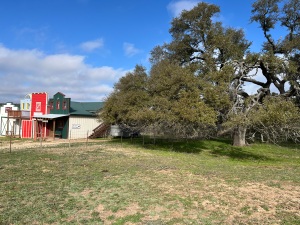The magnificent Live Oak trees in the Texas Hill Country are unique and beloved by residents and visitors alike. They vary in several ways from the clustered, closed-canopy, taller Oak trees found in the eastern part of the U.S.A. Just like many other aspects of Texas, our Live Oak Trees really are different.
To start with the form of our Live Oaks is broader and shorter than Oak Trees found elsewhere in the country. The thin, rocky soil of the Texas Hill Country along with frequent droughts give rise to this distinctive shape. These characteristics require the trees to have reduced height so that the limited water can be drawn up and into their leaves. Live Oaks spread out in a broad fashion, making drawing water much easier and with their gnarly limbs bending close to the ground, as if bowing in reverence to a demanding Mother Nature.

An Live Oak tree hundreds of years old that lost many of its limbs during the 2021 Ice Storm Uri and has yet to completely fill out its canopy
Live Oak trees are extremely drought tolerant. Even their small, thick leaves differ and for good reason from the large five or six lobed Oak leaves found elsewhere. Our Live Oak trees are also less clustered than eastern Oak trees, making the abundant sunlight even more available and the process of photosynthesis easier.
The Live Oak leaves are smaller, thicker, and stiffer. These adaptations help the tree to survive in its dry environment. As might be expected the largest Live Oaks are found in the valleys where the soil is thicker and groundwater more available.
Live Oak trees are always green. During March the leaves turn a yellowish green color and are pushed off by new leaves. Along with the Juniper tree, referred to locally as cedar, the Live Oak is always green.
During the wettest years Live Oak trees drop large numbers of acorns. The abundant acorns provide food for deer, feral pigs, and squirrels but must be buried in order to take root and grow into a tree. Squirrels bury large numbers of acorns, some of which are never retrieved. Serial wet years are necessary for a Live Oak sapling to sprout, making the likelihood of new Live Oak trees unlikely. The existing old trees are especially dear; some of which date to before the European explorers first roamed through this area.

This Live Oak either had its main trunk cut off during the 1950s severe drought or else lost it to weather, leaving an unusual shape for the tree
These mighty trees demonstrate amazing staying power and a floral grit. The striking temperature differences with single digit cold temperatures and blazing hot summers require it.
The great size and twisted trunks of Live Oaks never cease to create in me a sense of awe and wonderment. Live Oak trees are truly iconic to the Texas Hill Country and add further diversity to the flora and fauna of this region.
For those wishing to read more about the diversity of the Texas Hill Country may I suggest Armadillos To Ziziphus, by David M. Hillis. Dr. Hillis is a renowned biologist whose ranch, aptly named The Double Helix, teaches at the University of Texas at Austin. His book is chocked with wonderful insights about the incredible diversity of the Hill Country and is a great read.
If you haven’t had a chance to pick up a copy of my recent book, Hitler’s Maladies and Their Impact on World War II, I hope you will do so. Hitler’s poor physical and mental health provides insights into his diminished performance during the latter years of World War II but in no way mitigates his evil ways. Also my earlier book, Carrying The Black Bag: A Neurologist’s Bedside Tales remains available. Both books can be obtained from your favorite bookstore, the publisher, or the author at jthomas_hutton@yahoo.com.
Tagged: A Sense of Awe, A sense of wonderment, acorns, Effects of drought on flora, effects of storms on flora, fall, Live Oak trees, nature, oak-tree, Old Live Oak Trees, trees






Magnificent trees.